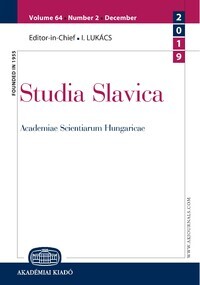Досвід моделювання аспектуальної парадигми полісемічного дієслова
Experience in Modelling the Aspectual Paradigm of a Polysemantic Verb
Author(s): Mykola Kalko, Valentyna KalkoSubject(s): Language studies
Published by: Akadémiai Kiadó
Keywords: aspectual macroparadigm; aspectual lexical microparadigm; aspectual grammatical microparadigm; aspectual pragmatic microparadigm; aspectual derivatological microparadigm; aspectual class; actional sub
Summary/Abstract: Based on the case of a modern Ukrainian polysemantic verb, the paper regards the perspective of employing the objective means for describing the categories of aspect and aspectuality, which focuses on the dependence of the assessment of the intratemporal nature of the situation on the ontological specification of the verb’s extralingual correlates that is significant to their linguistic category of arrangement and predominantly lies in differentiating between grammatical (aspect categories) and lexical (aspectuality classes) components of aspectuality. Carried out through appropriate investigatory means (i.e. complex aspectology survey), the paper supports that the approach enables to create an objective and detailed but not simplified or schematic model for the aspectual paradigm in a polysemantic verbal lexeme. The aspectual macroparadigm is constituted by: 1) an aspectual lexical microparadigm, consisting of aspectual lexical classes: terminative, activitive, stative, eventive, and relative; 2) an aspectual grammatical microparadigm with aspectual grammatical classes: imperfective partners, perfective partners, imperfeсtiva tantum, perfeсtiva tantum, and biaspectives; 3) an aspectual pragmatic microparadigm, integrating concrete aspect functions, among them progressive, iterative, praesens historicum, concrete factual, etc.; 4) an aspectual derivatological microparadigm, consolidating actional subclasses (traditional genders, or moods), like morphologic word-building prefixal, suffixal, and confixal derivatives: atenuatives, distributives, duratives, perduratives, saturatives, semelfactives, cumulatives, reduplicatives, etc. In the investigation, special attention should be paid to prefixless imperfective forms with diffusive semantics. The complex aspect-centred analysis of these verbs enables to single out all shades of aspectuality in the polysemantic meaning of the verb. Thus, modelling an aspectual paradigm of the polysemantic verb рвати ‘tear’ reveals some special semantic units found within its aspectual lexical paradigm: they clearly belong to 5 distinct aspectual classes, those of terminatives, activitives, eventives, statives, and relatives. The aspectual class signifies the correlative type of aspectual lexical, aspectual pragmatic, and aspectual derivatological microparadigms: actually, terminatives contain specifically aspectual, functional-aspectual, and actional partnership in progressive function. The 11 semantic units reflecting agentive action-aimed processes appear to be terminative ones. Activitives, eventives, statives, and relatives contain their own specific features depicted in the paper. The complex analysis of category arrangement rules for aspectual grammatical meaning under the objective approach, together with complex aspectual investigation, enables to reveal a range of aspectual markers found within a verb unit as well as its subtlest features of aspect character and, thus, to create an actual aspectual paradigm.
Journal: Studia Slavica Academiae Scientiarum Hungaricae
- Issue Year: 66/2021
- Issue No: 1
- Page Range: 53-65
- Page Count: 13
- Language: Ukrainian
- Content File-PDF

